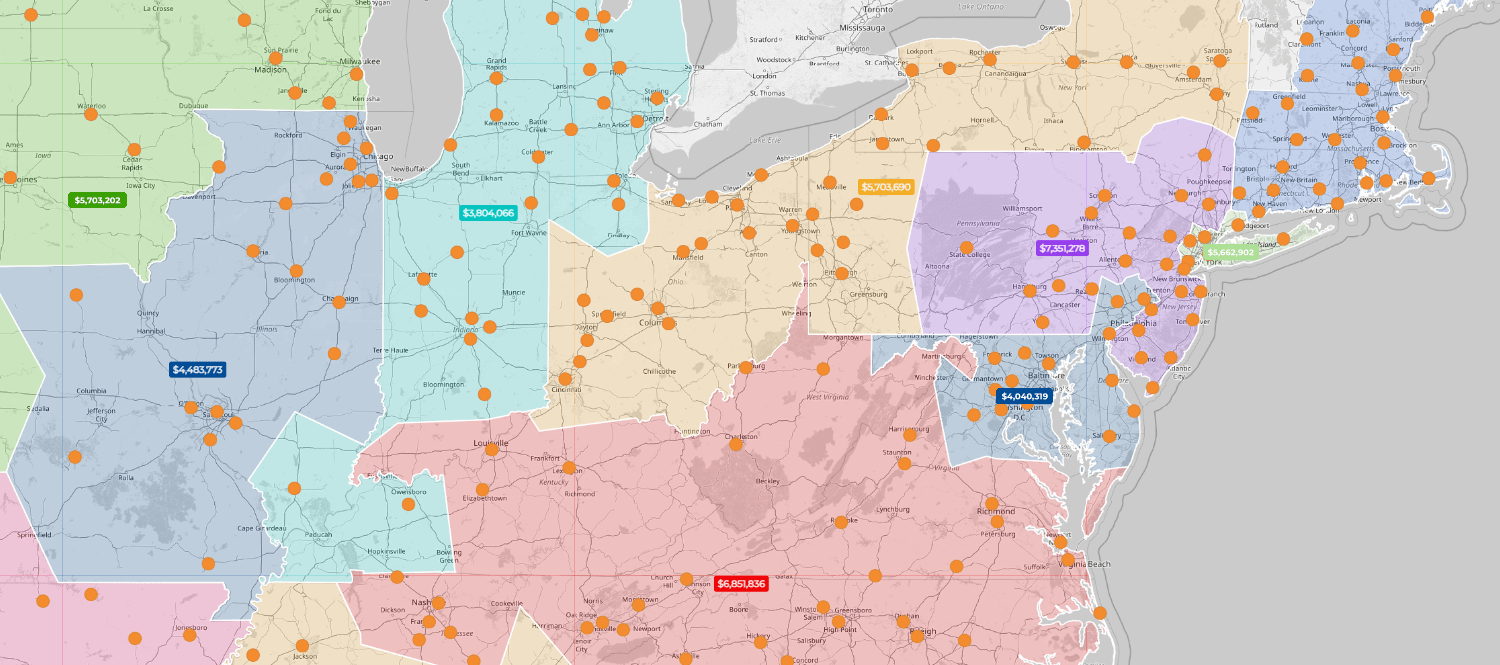- Blog
- Geo Mapping
- How to Create a Custom Territory Map
A territory map is essential for organizing teams, aligning goals, and visualizing geographic responsibility. Whether you’re managing sales regions, service areas, or distribution coverage, having a clear view of who owns what can drastically improve efficiency and accountability.
But if you’re still drawing boundaries by hand or using static documents, you’re missing out on the advantages of a dynamic, interactive solution. Here’s how to create a territory map that actually works for your business—without relying on complex software or manual guesswork.
What Is a Territory Map?
A territory map is a visual representation of geographic areas assigned to specific people, teams, or functions. These maps are commonly used by sales organizations to divide reps by region, but they’re just as valuable for service teams, franchise networks, logistics planners, and field ops managers.
Territory mapping helps reduce overlap, uncover gaps in coverage, and keep your team focused on the right accounts or service zones. It brings clarity to operational planning and helps ensure resources are distributed where they’ll have the most impact.


Pro Tip: Creating your first territory map is just the beginning. With Mapline, you can go further—add custom data layers, assign ownership to team members, and update maps in real time as your business grows. It’s more than a map. It’s a smarter way to manage your territory strategy—without adding complexity.
How to Create a Territory Map Without the Hassle
You could try making a territory map using static tools like spreadsheets, slide decks, or general-purpose mapping platforms. But those approaches tend to be manual, time-consuming, and hard to update. Drawing boundaries by hand or building maps from scratch in Excel can quickly become overwhelming—especially when your data changes or your team grows.
Mapline makes it easy to create a map without any technical training. You upload your data, define how you want to group it (ZIP codes, states, custom regions), and Mapline handles the rest. It’s fast, flexible, and designed specifically for territory management.
Create a Territory Map in Minutes Using Mapline
Getting started is simple. Here’s how to create it in Mapline:
- Upload your location data from an Excel or CSV file.
- Select how you want to group your territories—by ZIP code, state, or another field.
- Apply custom styling to distinguish different reps, regions, or zones.
- Share the live map with your team or export it as an image or PDF for presentations.
Within minutes, you’ll have a clean, interactive territory map that updates as your data changes—no rework required.
How to Create a Territory Map in Excel (and Why It’s Not Ideal)
Yes, it’s technically possible to create a territory map in Excel. You can color-code cells, insert basic shapes, and overlay ZIP codes manually. But the moment you need to scale, add new reps, or update your coverage, you’ll run into limitations. Excel wasn’t built for geographic mapping—and it shows.
Mapline, on the other hand, automatically groups and visualizes your data based on any field you choose. It also gives you the flexibility to edit territories, apply filters, and view live changes—something a spreadsheet just can’t do.
When and Why to Use a Custom Territory Map
Territory maps aren’t just about aesthetics—they’re about clarity, efficiency, and alignment. If you’re running a team that operates across regions or handles location-based tasks, you’ll benefit from a territory map that’s easy to create and even easier to maintain.
Whether you’re planning sales territories, optimizing service zones, assigning reps, or evaluating market coverage, having a map helps you act faster and plan smarter. It turns raw location data into something your whole team can understand and use immediately.
Conclusion
Creating a territory map doesn’t have to be complicated or time-consuming. With the right tool, you can go from spreadsheet to strategy in minutes—without touching a line of code or getting buried in manual work.
If you’re ready to skip the static maps and start visualizing territories the smarter way, Mapline gives you everything you need to build, edit, and share your custom territory maps—quickly, clearly, and for free.









